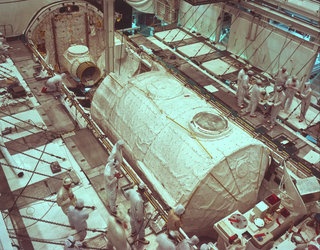Shuttle technical facts
The Space Transportation System (STS) is the formal name of NASA’s Space Shuttle, consisting of an aircraft-like orbiter, two boosters and a huge external tank.
The stack, as the composite of orbiter, tank and boosters is called, has a gross liftoff weight of 2000 tonnes. Its height is 56 m and the boosters with the three Space Shuttle Main Engines generate 30.16 MN of thrust.
Shuttle is able to loft about 24 tonnes of cargo to low orbit and transport typically seven astronauts.
Orbiter

The Orbiter is about the size of an Airbus A320 airliner, but sports the double-delta wings of a fighter. It has a crew compartment in the nose section, followed by a large payload bay and finally three main rocket engines in the aft fuselage.
The Orbiter structure is primarily aluminum alloy, with the engine structure primarily titanium alloy. The whole underbelly is covered by ceramic tiles protecting the Orbiter from the extreme heating of reentry. Each orbital vehicle was designed for 100 flights.
Specifications of Endeavour (OV-105)
Length: 37.237 m
Wingspan: 23.79 m
Height: 17.86 m
Empty weight: 78 000 kg
Gross liftoff weight: 110 000 kg
Maximum landing weight: 100 000 kg
Maximum payload: 25 060 kg
Payload to low Earth orbit: 24 310 kg
Payload bay dimensions: 4.6 x 18 m
Operational orbit altitude: 190 to 960 km
Orbital speed: 7743 m/s (27 870 km/h)
Crew: minimum of two, typically seven, maximum 11
Space Shuttle Main Engine (SSME)

Each Orbiter has three Rocketdyne Block II SSMEs, each with a sea level thrust of 1.752 MN at 104% power. The total thrust of three engines at liftoff is 5.255 MN.
The engines run on liquid oxygen and liquid hydrogen carried in the External Tank. The burn time of the engines is 480 seconds.
External Tank

The main role of the External Tank is to supply the liquid oxygen and hydrogen propellants to the main engines, but it also holds the attachment points for the two Solid Rocket Boosters and the Orbiter itself. The External Tank is the only non-reusable part of the Space Shuttle system.
Length: 46.9 m
Diameter: 8.4 m
Propellant volume: 2025 m3
Empty weight: 26 535 kg
Gross liftoff weight: 756 000 kg
Solid Rocket Boosters

Two solid rocket boosters (SRBs) each generate 12.5 MN of thrust at liftoff, totalling up to 83% of the total thrust needed. After two minutes of flight, the boosters are jettisoned at a height of about 45 km. They separate from the Shuttle, deploy parachutes and fall into the Atlantic Ocean for recovery.
The boosters have a very heavy-duty construction with steel cases about 13 mm thick. They are reused many times: as one example, an SRB segment from STS-1 flew six times in the following years plus one ground test.
The propellant mixture in the boosters consists of ammonium perchlorate (oxidiser), aluminum (fuel), iron oxide (a catalyst), a polymer that holds the mixture together and acts as secondary fuel and an epoxy curing agent.
Length: 45.46 m
Diameter: 3.71 m
Empty weight of one booster: 68 000 kg
Gross liftoff weight of one booster: 571 000 kg
Thrust at liftoff of one booster (at sea level): 12.5 MN
Burn time: 124 s















 Germany
Germany
 Austria
Austria
 Belgium
Belgium
 Denmark
Denmark
 Spain
Spain
 Estonia
Estonia
 Finland
Finland
 France
France
 Greece
Greece
 Hungary
Hungary
 Ireland
Ireland
 Italy
Italy
 Luxembourg
Luxembourg
 Norway
Norway
 The Netherlands
The Netherlands
 Poland
Poland
 Portugal
Portugal
 Czechia
Czechia
 Romania
Romania
 United Kingdom
United Kingdom
 Slovenia
Slovenia
 Sweden
Sweden
 Switzerland
Switzerland






























